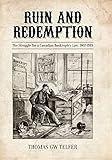Ruin and Redemption : The Struggle for a Canadian Bankruptcy Law, 1867-1919 / Thomas G. W. Telfer.
Material type: TextSeries: Osgoode Society for Canadian Legal HistoryPublisher: Toronto : University of Toronto Press, [2014]Copyright date: ©2014Description: 1 online resource (328 p.) : 4 figuresContent type:
TextSeries: Osgoode Society for Canadian Legal HistoryPublisher: Toronto : University of Toronto Press, [2014]Copyright date: ©2014Description: 1 online resource (328 p.) : 4 figuresContent type: - 9780802093431
- 9781442619685
- 346.7 23
- KE1499 .T44 2014eb
- online - DeGruyter
| Item type | Current library | Call number | URL | Status | Notes | Barcode | |
|---|---|---|---|---|---|---|---|
 eBook
eBook
|
Biblioteca "Angelicum" Pont. Univ. S.Tommaso d'Aquino Nuvola online | online - DeGruyter (Browse shelf(Opens below)) | Online access | Not for loan (Accesso limitato) | Accesso per gli utenti autorizzati / Access for authorized users | (dgr)9781442619685 |
Frontmatter -- Contents -- Illustrations, Figures and Tables -- Abbreviations -- Foreword -- Preface -- 1. Ideas, Interests and Institutions -- Part One. 1867–1880 -- 2. Constitutional and Legislative History 1867–1880 -- 3. The Rise and Fall of Bankruptcy Law 1867–1880: The Equitable Distribution of Assets -- 4. The Repeal of Bankruptcy Law 1867–1880: The Discharge -- 5. The Role of Institutions 1867–1880 -- Part TWO. 1880–1903 -- 6. Living with Repeal and the Failure of Federal Reform 1880–1903 -- 7. The Constitutional Question and the Impact of Federalism 1880–1903 -- 8. The Bankruptcy Law Debates 1880–1903 -- Part THREE. 1903–1919 -- 9. Reform Achieved: The Bankruptcy Act of 1919 -- 10. Conclusion -- Notes -- Bibliography -- Index
restricted access online access with authorization star
http://purl.org/coar/access_right/c_16ec
In 1880 the federal Parliament of Canada repealed the Insolvent Act of 1875, leaving debtor-creditor matters to be regulated by the provinces. Almost forty years later, Parliament finally passed new bankruptcy legislation, recognizing that what was once considered a moral evil had become a commercial necessity. In Ruin and Redemption, Thomas G.W. Telfer analyses the ideas, interests, and institutions that shaped the evolution of Canadian bankruptcy law in this era. Examining the vigorous public debates over the idea of bankruptcy, Telfer argues that the law was shaped by conflict over the morality of release from debts and by the divergence of interests between local and distant creditors. Ruin and Redemption is the first full-length study of the origins of Canadian bankruptcy law, thus making it an important contribution to the study of Canada’s commercial law.
Mode of access: Internet via World Wide Web.
In English.
Description based on online resource; title from PDF title page (publisher's Web site, viewed 01. Dez 2023)


